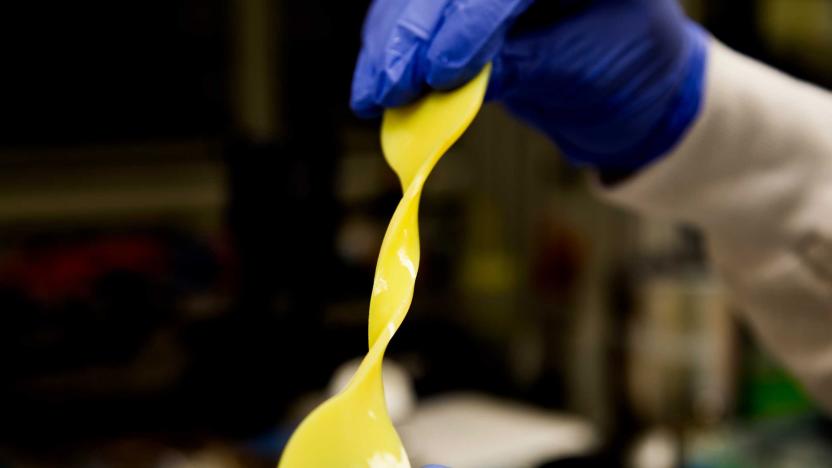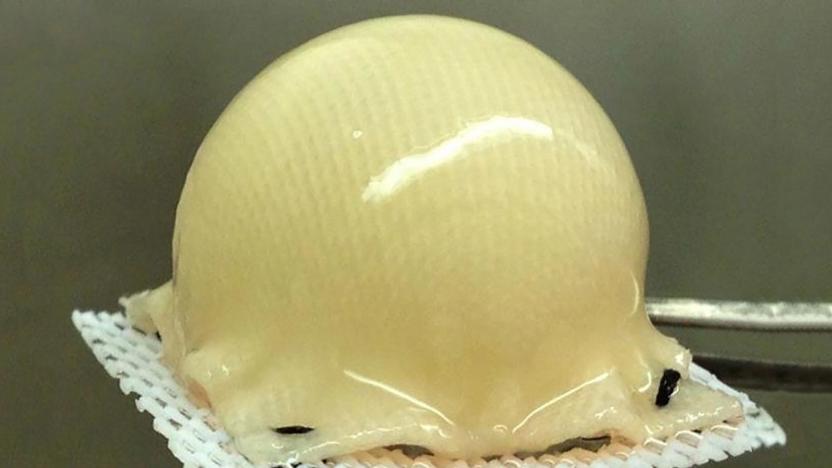cartilage
Latest

Skeletal stem cells could regrow damaged bones
Believe it or not, scientists are still discovering new forms of stem cells -- and these latest examples could shake up how doctors treat a multitude of common injuries. A Stanford-led research team has identified the human skeletal stem cell, helping the group create a "family tree" of cells that can regenerate bones and cartilage. You can either isolate them from existing bones or generate them from specialized cells in fat, and they're predictable enough (that is, they'll always make bone tissue) that doctors wouldn't have to worry much about unintended results when using them in treatments.

Kevlar cartilage could help you recover from joint injuries
It can be difficult to fully recover from knee injuries or other damage to your joints, if just because there hasn't been an artificial replacement for cartilage that can withstand as much punishment as the real thing. That may not be an issue in the long run, though: scientists have developed a Kevlar-based hydrogel that behaves like natural cartilage. It mixes a network of Kevlar nanofibers with polyvinyl alcohol to absorb water at rest (like real cartilage does in idle moments) and become extremely resistant to abuse, but releases it under stress -- say, a workout at the gym.

Stem cell-based cartilage could fix your broken hip
Doctors want to 3D print transplantable organs from your own stem cells, but now they might be able to replace a bum hip, too. A team of scientists in St. Louis and Durham used stem cells to grow cartilage on a 3D "scaffold" that can be molded into the exact shape of a patient's hip joint. It could then be implanted onto the surface of the bone, replacing the regular cartilage that acts as a "lubricant" for the ball and socket-style joint. Since it would be made from your own stem cells, there's no chance of rejection.

ICYMI: Brightest X-ray laser, 3D printing cartilage and more
#fivemin-widget-blogsmith-image-741239{display:none;} .cke_show_borders #fivemin-widget-blogsmith-image-741239, #postcontentcontainer #fivemin-widget-blogsmith-image-741239{width:570px;display:block;} try{document.getElementById("fivemin-widget-blogsmith-image-741239").style.display="none";}catch(e){}Today on In Case You Missed It: Stanford's National Accelerator Laboratory is upgrading a laser beam to make it the brightest X-ray laser in the world, enabling all sorts of as-yet unseen science. Popular Chinese phone maker Xiaomi makes a ceramic-backed phone that appears to be near indestructible. And medical researchers are using patient-derived, stem-cell cartilage to repair joints by 3D-drawing them when doing surgery, rather than harvest existing cartilage from elsewhere on the body. We'd also like to share this video of the cutest little BB-8 cosplay artist. As always, please share any great tech or science videos you find by using the #ICYMI hashtag on Twitter for @mskerryd.

'Biopen' lets doctors 3D print cartilage during surgery
If you need knee replacement surgery in the future, doctors may be able to create a custom-made joint from your own stem cells. A team from St Vincent's Hospital, Melbourne, have developed the Biopen, a type of 3D printer that uses "ink" made from hydrogel and stem cells. While 3D printing stem cells isn't new, the exact shape of a patient's cartilage often can't be known until they're cut open. Using the device, surgeons can precisely customize the joint to the patient with surgical "scaffolds," then permanently harden the biogel using ultraviolet light.

Researchers can now 3D-print nose cartilage in 16 minutes
Doctors have been employing 3D-printed tissue for years now. But even though the hype around 3D bioprinting has raised expectations that it will save lives and shorten donor wait lists, fully functional printed organs are not feasible yet. While we won't be seeing blood pumping printed hearts any time soon, getting a new nose could become easier.

Scientists 3D print cartilage to repair damaged windpipes
Believe it or not, scientists aren't yet finished discovering new ways to 3D print body parts. A team at the Feinstein Institute for Medical Research has developed a 3D printing technique that lets them produce cartilage for repairing damaged tracheas, better known to you and I as windpipes. They use an off-the-shelf 3D printer (in this case, a MakerBot Replicator 2X Experimental) to create a scaffold for the cartilage out of the same PLA filament you'd use for everyday 3D printing projects. After that, they cover the scaffold in a mix of chondrocytes (healthy cartilage cells) and collagen, 'baking' it in a custom bioreactor to make sure the cells grow properly.

Hybrid 3D printer could fast-track cartilage implants
Most of the attention surrounding 3D printers in medicine has focused on patching up our outsides, whether it's making skin to heal wounds or restoring the use of limbs. The Wake Forest Institute for Regenerative Medicine has just detailed a technique that could go considerably deeper. By mixing natural gel put through an inkjet printer with thin and porous polymer threads coming from an electrospinner, researchers have generated constructs that could be ideal for cartilage implants: they encourage cell growth in and around an implant while remaining durable enough to survive real-world abuse. Early tests have been confined to the lab, but the institute pictures a day when doctors can scan a body part to produce an implant that's a good match. If the method is ultimately refined for hospital use, patients could recover from joint injuries faster or more completely -- and 3D printers could become that much more integral to health care.



